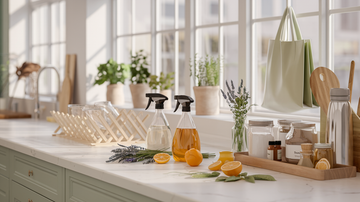Table of Contents
- Why Sustainable Living Matters for Your Health and Home
- Getting Started: First Steps to a Sustainable Home
- Kitchen Sustainability Made Simple
- Creating an Eco-Friendly Bathroom
- Natural Cleaning: The Foundation of a Sustainable Home
- Beyond Cleaning: Other Simple Sustainable Swaps
- The Mindset Shift: Sustainable Living as a Journey
- Conclusion: Your Sustainable Living Journey Starts Now
Standing in the cleaning aisle of your local supermarket, you squint at yet another product label filled with unpronounceable chemicals. You wonder: "Is this really what I want in my home, around my family, and eventually, in our environment?" If you've ever asked yourself this question, you're already taking the first step toward sustainable living.
Sustainable living isn't just a trend—it's a practical approach to creating a healthier home environment while reducing your environmental footprint. But for many first-timers, the journey can seem overwhelming. Where do you start? How expensive will it be? Will it actually make a difference?
The good news is that sustainable living doesn't require a complete lifestyle overhaul overnight. Small, consistent changes—especially in how we clean and maintain our homes—can have significant impacts on both our health and the planet. In this guide, we'll walk you through simple, affordable steps to begin your sustainable home journey, with a special focus on creating a non-toxic living environment through smarter cleaning choices.
Sustainable Living Essentials
Simple steps to create a healthier home environment
Creating a sustainable home doesn't require a complete lifestyle overhaul. Start with these simple, effective changes that improve both your health and the environment.
Take Inventory
Examine current products for warning labels and harmful ingredients. Use up what you have before replacing them with sustainable alternatives.
Switch to Natural Cleaning
Replace chemical cleaners with enzymatic solutions. They break down dirt naturally without leaving toxic residues while being child-safe.
Reduce Single-Use Items
Replace disposables with reusable alternatives: cloth napkins, shopping bags, glass containers, and washable cleaning cloths.
Room-by-Room Sustainable Solutions
Kitchen
- Replace plastic containers with glass or stainless steel
- Use enzymatic cleaners for counters and surfaces
- Start kitchen composting for food waste
Bathroom
- Install a low-flow showerhead to reduce water
- Use enzyme cleaners for toilet and tile cleaning
- Switch to solid soap bars and shampoo bars
Living Areas
- Replace incandescent bulbs with LED lighting
- Install smart power strips for electronics
- Choose natural, non-toxic air fresheners
Sustainable Living Mindset
Progress Over Perfection
Focus on consistent small changes rather than attempting a complete lifestyle overhaul all at once.
Find Community
Connect with others on similar journeys to share challenges, solutions, and celebrate sustainable victories.
Start Your Sustainable Journey Today
Small, consistent changes in how you clean and maintain your home can have significant impacts on both your health and the planet.
Why Sustainable Living Matters for Your Health and Home
Before diving into practical tips, let's understand why sustainable living deserves your attention. Conventional home products—particularly cleaning supplies—often contain harsh chemicals that can leave toxic residues on surfaces, in the air, and eventually in our bodies. Research has linked common household chemicals to respiratory issues, skin irritations, hormonal disruptions, and even long-term health concerns.
Beyond personal health, these products impact our shared environment. Chemical residues wash down drains, eventually reaching waterways and affecting aquatic ecosystems. Plastic packaging contributes to the growing waste crisis. Manufacturing processes often consume substantial resources and energy.
Sustainable living offers an alternative path: one where your home becomes a healthier sanctuary while your daily choices contribute to environmental wellbeing. It's about making intentional decisions that benefit both your immediate living space and the wider world.
Getting Started: First Steps to a Sustainable Home
The journey toward sustainability begins with awareness and simple adjustments. Here are foundational steps for beginners:
Take Inventory of Current Products
Start by examining what you currently use in your home. Check labels on cleaning products, personal care items, and household goods. Look for terms like "Warning," "Caution," or "Danger"—these indicate potentially harmful ingredients. Don't feel pressured to replace everything immediately; instead, prioritize items you use most frequently or those with the most concerning ingredients.
Adopt the Use-It-Up Philosophy
Sustainability doesn't mean throwing everything away to start fresh. A more environmentally responsible approach is to use up what you have (unless it poses immediate health concerns) and then replace items with better alternatives when they're depleted. This reduces waste while making the transition more financially manageable.
Research Before You Buy
Before purchasing new "green" products, do your homework. Unfortunately, greenwashing (making misleading environmental claims) is common. Look for specific information about ingredients rather than vague terms like "natural" or "eco-friendly." Seek out brands that offer transparency about their sourcing, manufacturing processes, and packaging choices.
Kitchen Sustainability Made Simple
The kitchen often represents the heart of household consumption and waste generation, making it an excellent starting point for your sustainable journey.
Non-Toxic Food Storage
Gradually replace plastic food containers with glass or stainless steel alternatives. Not only do these options avoid potential chemical leaching, but they also last significantly longer, reducing waste. For wrapping foods, consider beeswax wraps as an alternative to plastic cling film—they're reusable, compostable, and surprisingly effective.
Counter and Surface Cleaning
Kitchen surfaces demand frequent cleaning but don't require harsh chemicals. Enzymatic cleaners, like those offered in Green Kulture's Natural Cleaners collection, use fruit and vegetable enzymes to break down food residues, grease, and bacteria naturally—without leaving harmful chemical residues where you prepare food.
Mindful Waste Management
Start a simple kitchen composting system for food scraps. Even apartment dwellers can use compact composting methods like bokashi bins or small countertop collectors. For recycling, create a dedicated station with clearly labeled bins. Research your local recycling guidelines to ensure you're sorting correctly—improper recycling can sometimes do more harm than good.
Creating an Eco-Friendly Bathroom
The bathroom presents unique sustainability challenges, from water consumption to personal care product packaging.
Water Conservation
Install a low-flow showerhead—a simple change that can reduce water usage by up to 60% without sacrificing shower quality. Fix leaky faucets promptly; even slow drips waste surprising amounts of water over time. Consider placing a filled water bottle in your toilet tank to reduce the water used per flush if you're not ready to upgrade to a low-flow toilet.
Toilet and Tile Cleaning
Bathroom cleaning often involves the harshest household chemicals, but it doesn't have to. Multi-enzyme technology cleaners break down organic material effectively without caustic ingredients. They're particularly effective for soap scum and biological residues common in bathrooms. For toilet cleaning, enzymes work wonderfully to digest waste and eliminate odors naturally.
Personal Care Product Swaps
As you finish your current products, replace them with more sustainable alternatives. Consider solid soap bars instead of liquid body wash in plastic bottles, shampoo bars instead of bottled shampoo, and safety razors instead of disposable ones. These simple swaps dramatically reduce bathroom plastic waste over time.
Natural Cleaning: The Foundation of a Sustainable Home
Perhaps no single change impacts both home health and environmental footprint more than switching to natural cleaning methods.
Understanding Enzymatic Cleaning
Enzymatic solutions represent the cutting edge of natural cleaning technology. Unlike conventional cleaners that use harsh chemicals to kill bacteria and dissolve dirt, enzymatic cleaners work by breaking down organic compounds into smaller, harmless substances that can be easily wiped away. This process is similar to how enzymes in our digestive system break down food.
Green Kulture's Natural Cleaners utilize multi-enzyme technology derived from fruit and vegetable enzymes. These solutions effectively target different types of household dirt—from protein-based stains to grease and carbohydrate residues—all while remaining non-toxic and child-safe.
All-Purpose Cleaning
For daily wipe-downs and general cleaning, enzymatic all-purpose cleaners offer versatility without harsh chemicals. They're effective on counters, floors, walls, and most hard surfaces. Unlike bleach or ammonia-based cleaners that simply dissolve dirt (often leaving chemical residue behind), enzymatic cleaners continue working until the organic material is completely broken down.
Specialized Cleaning Tasks
Even challenging cleaning situations have natural solutions. Stubborn mold and mildew respond well to enzymatic cleaners specifically formulated for bathroom environments. For glass cleaning, simple solutions of water with a small amount of vinegar or alcohol can replace ammonia-based window cleaners. Baking soda makes an excellent mild abrasive for scouring when needed.
Making Cleaning Products Last
To maximize sustainability, look for cleaning products available in concentrated forms or with refill options. Green Kulture offers refill options for their products, reducing packaging waste significantly. When purchasing, consider bundle options to save both money and packaging materials.
Beyond Cleaning: Other Simple Sustainable Swaps
While natural cleaning forms a cornerstone of sustainable living, other small changes compound the positive impact.
Energy Conservation
Replace incandescent bulbs with LED alternatives as they burn out—LEDs use up to 75% less energy and last 25 times longer. Install smart power strips for electronics to eliminate phantom energy usage when devices are turned off but still plugged in. Consider a programmable thermostat to optimize heating and cooling when you're not home.
Reduced Single-Use Items
Identify and replace disposable items in your home one by one. Switch to cloth napkins instead of paper, reusable shopping bags instead of plastic, and washable cleaning cloths instead of paper towels. Keep reusable water bottles and coffee cups for on-the-go hydration rather than purchasing disposable options.
Conscious Consumption
Before making any purchase, consider whether you truly need the item. For necessary purchases, research companies with sustainable practices. Look for products with minimal packaging, recycled content, or compostable materials. Quality often trumps quantity in sustainable living—investing in durable items reduces the frequency of replacement and associated resource consumption.
The Mindset Shift: Sustainable Living as a Journey
Perhaps most importantly, sustainable living requires a shift in perspective—one that values progress over perfection.
Embracing Imperfection
No one achieves perfect sustainability, especially at first. Each small change contributes to the larger goal. When you slip up or make less sustainable choices out of necessity, practice self-compassion rather than giving up entirely. Remember that consistent small actions collectively create significant impact.
Creating New Habits
Sustainable living becomes easier as actions transform into habits. Focus on one change at a time until it becomes automatic before adding additional practices. This approach prevents overwhelm and increases the likelihood that changes will stick. Consider keeping a journal of the changes you've implemented—seeing your progress can provide motivation to continue.
Finding Community
Connect with others on similar journeys through local sustainability groups, online forums, or social media communities. Sharing challenges, solutions, and victories makes the process more enjoyable and sustainable over the long term. These connections also provide valuable information about local resources and options.
Conclusion: Your Sustainable Living Journey Starts Now
Sustainable living isn't about achieving instant perfection or making huge sacrifices. Rather, it's about intentional choices that gradually create a healthier home environment while reducing your environmental impact. The journey begins with awareness and advances through consistent small changes—particularly in how you clean and maintain your living spaces.
By switching to enzymatic cleaning solutions like those offered by Green Kulture, you immediately eliminate a significant source of household toxins while supporting environmentally responsible manufacturing practices. From there, each additional sustainable choice—from reducing single-use plastics to conserving energy—compounds the positive impact.
Remember that sustainable living is both a personal and collective journey. Your individual choices matter not only for your immediate health and home environment but as part of a larger movement toward more conscious consumption and environmental stewardship. Start where you are, use what you have, and do what you can—each step forward makes a difference.
Ready to take your first step toward sustainable living? Explore Green Kulture's range of natural, enzymatic cleaning solutions at https://greenkulture.sg/ and discover how easy it is to create a healthier home environment today. Check out our current promotions to make your sustainable switch even more affordable!





